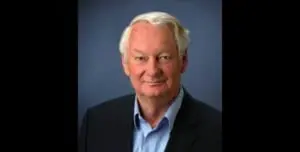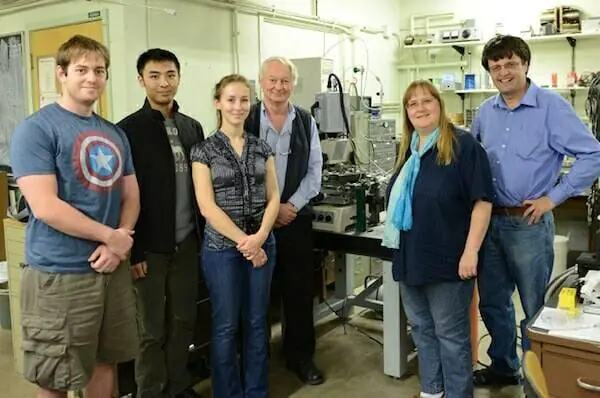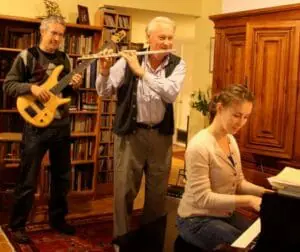
John Spence, a researcher in the Biodesign Center for Applied Structural Discovery, the Richard Snell Professor of Physics and ASU Regents Professor, died peacefully Monday morning, June 28, in Boston.
Spence’s career spanned more than 40 years at ASU, where early on he was a key contributor to ASU’s world-renowned program in electron microscopy and, most recently, was the director of science for the NSF BioXFEL Science and Technology Center on the application of X-ray free-electron (XFEL) lasers to structural biology.
“John will be missed by all, like me, who loved his mind and the unlimited expression of his kind self,” said ASU President Michael Crow. “He was both a human master of the universe, as in the best we have to understand what we are, and a soulful human who was committed to the betterment of our small rural planet and our evolving species. He understood all of this and used his life to express how to move us all forward.
“We have lost a great one, and our university and our community are better off by immense measure for having known and been taught by John.”
An ASU research pioneer
In parallel developments over the past 40 years, electron microscopes and large particle accelerator-sized lasers have been used in biology to image the protein molecules in cells, and these same principles can now be applied to see these molecular machines within organisms at the near-atomic level.
Spence’s links to ASU began in the mid-1970s. In 1970, the same year that atoms were first observed directly by electron microscope, Professor John Cowley joined ASU’s Physics Department. Cowley, already an internationally recognized authority in electron microscopy (EM), later obtained a large NSF Regional Center grant, one of the first major research programs at ASU.

Cowley established a world-leading school of EM, with faculty appointments, many students and postdoctoral researchers and the latest equipment, including half a dozen EM instruments.
Soon after, Cowley recruited Spence and Sumio Iijima, along with Ondrej Krivanek and David Smith, all of whom made major contributions to the field.

In 1974, ASU launched the LeRoy Eyring Center for Solid State Science (CSSS), named for its founder. Eyring joined ASU in 1961 as chair of the Chemistry Department, which he helped build into one of the finest in the country. The center provides researchers with open access to sophisticated techniques for materials characterization and high-resolution EM. The Eyring Materials Center has remained a leading international center for the development of new techniques for imaging and analyzing atomic structures in matter.
Among Spence’s achievements were the first direct-detection EM cameras. A CCD (charge-coupled device camera) system for electron microscopy was first developed in 1986 at ASU in the Spence group. After seven years of research and development starting in 2001, a new sensor was invented that can make an image from electrons themselves, improving achievable resolution.
In 2012, a new home for the most sensitive electron microscopes, the Southwestern Center for Aberration Corrected Electron Microscopy, opened on ASU's Tempe campus. This building was designed to house four electron microscopes, with the fourth bay reserved for a new instrument, called cryo-EM, dedicated to biology.
Spence led a team of ASU researchers who received a three-year, $2.8 million award from the National Science Foundation to make his dream of cryo-EM a reality. ASU administration and faculty contributed additional funds, while many faculty across other Southwestern campuses have been using the new machine to publish new research in structural biology.
For his microscopy achievements, Spence received the Distinguished Scientist Award of the Microscopy Society of America in 2006, the Buerger Award of the American Crystallographic Society in 2012, the J.M. Cowley Medal of the International Federation of Societies of Microscopy in 2014, the Burton Medal of MSA and a Humboldt Senior Scientist Award.

Using particle accelerators to get to the heart of matter
Meanwhile, Spence had another major scientific advancement running in parallel — a high-risk, high-reward idea of using the power of particle accelerators to see the inner workings of nature at the atomic scale — and one that the scientific naysayers said would never work. But Spence and his colleagues, Janos Hajdu from Uppsala University, Sweden, and Henry Chapman from Hamburg University and DESY laboratory in Germany, proved them wrong.
The project began under the guidance of the U.S. Department of Energy’s SLAC laboratory, with the intent to come up with biological applications for X-ray lasers that were paired with the power of mile-long particle accelerators (BioXFEL). But first, they needed to overcome a formidable issue: the radiation power of large particle accelerators that was needed to see molecules at near-atomic scale often would quickly obliterate the delicate crystal samples before any data could be collected. Then, in 2000, Hajdu and Richard Neutze published a game-changing paper that theorized a way to not only record images of the mechanisms but also produce a movie showing them at work.
Next, in 2006, experimental work led by Chapman proved for the first time that it was possible to “outrun” the radiation damage by using a very short pulse of the powerful X-ray beam. As the technique’s name implies, the light pulses occur over an astonishingly short time frame, measured in femtoseconds. A femtosecond is one quadrillionth of a second. To give a sense of just how brief this is, one femtosecond is to one second as one second is to about 32 million years.
In parallel in Arizona, Spence’s lab was building a device for sample delivery as well as crystallographic, data-deciphering algorithms. Despite the project being high risk at the time, the appeal was undeniable as Chapman’s experiments showed potential. The complexities of the project were also clear early on, such as the X-ray laser’s instability and scientific hurdles to overcome with the sample injection device.
In 2010, Spence was part of a worldwide team to develop the first theory and methodology to dig deeper into the biological world using XFELs.
His team consisted of professors Petra Fromme, Uwe Weierstall, Rick Kirian, Alex Ros, Brenda Hogue and Bruce Doak. Fromme created the microcrystals that led to the first success of the project. Doak, Weierstall and Spence were then able to extend the recording time for the images. Weierstall built the first sample delivery device for the microcrystals, which was further refined by Doak. The synergy of the ASU BioXFEL team even extended outside the lab — with the formation of the "Who Knew," a bossa nova band that recorded an album and performed at the yearly BioXFEL conferences.
The X-ray laser structural biology work was ranked among the top 10 scientific breakthroughs of 2012 by Science magazine.
In 2013, they secured $50 million in funding from the National Science Foundation to form a seven-university BioXFEL Science and Technology Center (ASU, Stanford, University of Wisconsin-Milwaukee, Cornell, Rice, State University of New York at Buffalo and University of California-San Francisco). The XFEL consortium has been devoted to the development and application of hard X-ray lasers to biology for the last decade. This funding gave the team the opportunity to focus on diseases that have evolved to evade the effects of antibiotics, and to make movies of proteins in action.
In 2019, ASU received a $10 million gift to enable the completion of the first room-sized version of the technology, the Beus Compact X-ray Free Electron Laser (CXFEL) Lab, to make the technology more accessible to the worldwide research community and to speed up the pace of discovery. Donated by Leo and Annette Beus, the gift has funded this first-of-its-kind compact X-ray technology in the world. With nearly the same performance as the mile-long XFELs, the instrument has potential applications in medicine, the renewable energy economy, the computer industry and beyond.
In 2020, the Royal Swedish Academy of Sciences awarded one of the physics research community’s highest honors, the prestigious Gregori Aminoff Crystallography Prize, to John Spence and his colleagues Janos Hajdu from Uppsala University, Sweden, and Henry Chapman from Hamburg University and DESY laboratory in Germany.
They received the award in honor of their innovative work in the structural imaging of molecular mechanisms with powerful X-ray free electron lasers. Their work provided the foundation to precisely see molecular machines like biomolecules, a major advancement for the field of structural biology and its potential applications to improve drug targeting, pharmaceuticals and renewable energy.
“Besides his scientific brilliance, John will be remembered for his personal kindness, including to me as the new chair, and his caring attitude as a teacher and mentor,” said Patricia Rankin, chair of the Department of Physics.
“His books were bestsellers in the community — required reading for every microscopist. Among many achievements in crystallography, he will be remembered for the work he did with ASU’s Michael O’Keeffe in imaging chemical bonds.”
Spence's zest as a science writer was on display in his recent book "Lightspeed" (Oxford University Press, 2019). During a sabbatical, Spence visited many of the places where the historical measurements of the speed of light were first made, and he told the tale of the improbable connections between the search for an absolute frame of reference in the universe (the Aether) and Einstein's theories leading to the equivalence of mass and energy.
“He was remarkable in so many ways, from his pioneering accomplishments in multiple fields of physics, to his renaissance scholarship, to his personal hobbies of sailing, soaring and music,” said former Department of Physics chair and longtime colleague Peter Bennett.
“Most remarkable however was his totally unassuming persona that radiated kindness, generosity, curiosity and youthful energy. He was a personal hero for me as a scientist, colleague and friend. My memories of John span from early days as a fellow Moon Dog (Spence’s band name) to a recent colloquium on 'Lightspeed,' delivered to a packed room of colleagues here at ASU. It was particularly rewarding to engage with him as department chair over the past seven years. He delivered consistently at the highest level, in the department and across the university, all while making it look easy. His passing is an immeasurable loss to us all.”
Spence leaves behind his wife, Margaret, sister Penny, and son Andrew.
